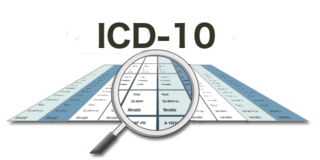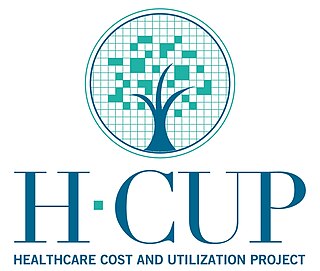Related Research Articles
The International Classification of Diseases (ICD) is a globally used medical classification used in epidemiology, health management and for clinical purposes. The ICD is maintained by the World Health Organization (WHO), which is the directing and coordinating authority for health within the United Nations System. The ICD is originally designed as a health care classification system, providing a system of diagnostic codes for classifying diseases, including nuanced classifications of a wide variety of signs, symptoms, abnormal findings, complaints, social circumstances, and external causes of injury or disease. This system is designed to map health conditions to corresponding generic categories together with specific variations, assigning for these a designated code, up to six characters long. Thus, major categories are designed to include a set of similar diseases.
Nosology is the branch of medical science that deals with the classification of diseases. Fully classifying a medical condition requires knowing its cause, the effects it has on the body, the symptoms that are produced, and other factors. For example, influenza is classified as an infectious disease because it is caused by a virus, and it is classified as a respiratory infection because the virus infects and damages certain tissues in the respiratory tract. The more that is known about the disease, the more ways the disease can be classified nosologically.

Coccidioides immitis is a pathogenic fungus that resides in the soil in certain parts of the southwestern United States, northern Mexico, and a few other areas in the Western Hemisphere.
The National Center for Health Statistics (NCHS) is a U.S. government agency that provides statistical information to guide actions and policies to improve the public health of the American people. It is a unit of the Centers for Disease Control and Prevention (CDC) and a principal agency of the U.S. Federal Statistical System. It is headquartered at University Town Center in Hyattsville, Maryland, just outside Washington, D.C.
A medical classification is used to transform descriptions of medical diagnoses or procedures into standardized statistical code in a process known as clinical coding. Diagnosis classifications list diagnosis codes, which are used to track diseases and other health conditions, inclusive of chronic diseases such as diabetes mellitus and heart disease, and infectious diseases such as norovirus, the flu, and athlete's foot. Procedure classifications list procedure code, which are used to capture interventional data. These diagnosis and procedure codes are used by health care providers, government health programs, private health insurance companies, workers' compensation carriers, software developers, and others for a variety of applications in medicine, public health and medical informatics, including:
The Current Procedural Terminology (CPT) code set is a procedural code set developed by the American Medical Association (AMA). It is maintained by the CPT Editorial Panel. The CPT code set describes medical, surgical, and diagnostic services and is designed to communicate uniform information about medical services and procedures among physicians, coders, patients, accreditation organizations, and payers for administrative, financial, and analytical purposes. New editions are released each October, with CPT 2021 being in use since October 2021. It is available in both a standard edition and a professional edition.
The ICD-10 Procedure Coding System (ICD-10-PCS) is a US system of medical classification used for procedural coding. The Centers for Medicare and Medicaid Services, the agency responsible for maintaining the inpatient procedure code set in the U.S., contracted with 3M Health Information Systems in 1995 to design and then develop a procedure classification system to replace Volume 3 of ICD-9-CM. ICD-9-CM contains a procedure classification; ICD-10-CM does not. ICD-10-PCS is the result. ICD-10-PCS was initially released in 1998. It has been updated annually since that time. Despite being named after the WHO's International Classification of Diseases, it is a US-developed standard which is not used outside the United States.
Procedure codes are a sub-type of medical classification used to identify specific surgical, medical, or diagnostic interventions. The structure of the codes will depend on the classification; for example some use a numerical system, others alphanumeric.
In health care, diagnosis codes are used as a tool to group and identify diseases, disorders, symptoms, poisonings, adverse effects of drugs and chemicals, injuries and other reasons for patient encounters. Diagnostic coding is the translation of written descriptions of diseases, illnesses and injuries into codes from a particular classification. In medical classification, diagnosis codes are used as part of the clinical coding process alongside intervention codes. Both diagnosis and intervention codes are assigned by a health professional trained in medical classification such as a clinical coder or Health Information Manager.
The International Classification of Health Interventions (ICHI) is a system of classifying procedure codes being developed by the World Health Organization (WHO). It is currently available as a beta 3 release. The components for clinical documentation are stable. The component on public health interventions is in the process of being finalized. Updates on development and status of the classification are listed on WHO home page.
MEDCIN, a system of standardized medical terminology, is a proprietary medical vocabulary and was developed by Medicomp Systems, Inc. MEDCIN is a point-of-care terminology, intended for use in Electronic Health Record (EHR) systems, and it includes over 280,000 clinical data elements encompassing symptoms, history, physical examination, tests, diagnoses and therapy. This clinical vocabulary contains over 38 years of research and development as well as the capability to cross map to leading codification systems such as SNOMED CT, CPT, ICD-9-CM/ICD-10-CM, DSM, LOINC, CDT, CVX, and the Clinical Care Classification (CCC) System for nursing and allied health.
A clinical coder—also known as clinical coding officer, diagnostic coder, medical coder, or nosologist—is a health information professional whose main duties are to analyse clinical statements and assign standardized codes using a classification system. The health data produced are an integral part of health information management, and are used by local and national governments, private healthcare organizations and international agencies for various purposes, including medical and health services research, epidemiological studies, health resource allocation, case mix management, public health programming, medical billing, and public education.

ICD-10 is the 10th revision of the International Statistical Classification of Diseases and Related Health Problems (ICD), a medical classification list by the World Health Organization (WHO). It contains codes for diseases, signs and symptoms, abnormal findings, complaints, social circumstances, and external causes of injury or diseases. Work on ICD-10 began in 1983, became endorsed by the Forty-third World Health Assembly in 1990, and was first used by member states in 1994. It was replaced by ICD-11 on January 1, 2022.

The history of chronic fatigue syndrome is thought to date back to the 19th century and before.
OPCS-4, or more formally OPCS Classification of Interventions and Procedures version 4, is the procedural classification used by clinical coders within National Health Service (NHS) hospitals of NHS England, NHS Scotland, NHS Wales and Health and Social Care in Northern Ireland. It is based on the earlier Office of Population Censuses and Surveys Classification of Surgical Operations and Procedures, and retains the OPCS abbreviation from this now defunct publication.

The Healthcare Cost and Utilization Project is a family of healthcare databases and related software tools and products from the United States that is developed through a Federal-State-Industry partnership and sponsored by the Agency for Healthcare Research and Quality (AHRQ).
The ICD-11 is the eleventh revision of the International Classification of Diseases (ICD). It replaces the ICD-10 as the global standard for recording health information and causes of death. The ICD is developed and annually updated by the World Health Organization (WHO). Development of the ICD-11 started in 2007 and spanned over a decade of work, involving over 300 specialists from 55 countries divided into 30 work groups, with an additional 10,000 proposals from people all over the world. Following an alpha version in May 2011 and a beta draft in May 2012, a stable version of the ICD-11 was released on 18 June 2018, and officially endorsed by all WHO members during the 72nd World Health Assembly on 25 May 2019.

Intelligent Medical Objects (IMO) is a privately held company specializing in developing, managing and licensing medical vocabularies. IMO partners with various health care organizations, medical content providers and EHR developers.
The ICD coding for rare diseases is the International Classification of Diseases code used for the purpose of documenting rare diseases. It is important for health insurance reimbursement, administration, epidemiology, and research. Of the approximately 7,000 rare diseases, only about 500 have a specific code. However, more than 5400 rare diseases are included in ICD-11 and can be recorded using an ICD-11 URI. An ICD code is needed for a person's medical records—it is important for health insurance reimbursement, administration, epidemiology, and research. Finding the best ICD code for a patient who has a rare disease can be a challenge.
References
- ↑ Cartwright, Donna J. (December 2013). "ICD-9-CM to ICD-10-CM Codes: What? Why? How?". Advances in Wound Care. 2 (10): 588–592. doi:10.1089/wound.2013.0478. ISSN 2162-1918. PMC 3865615 . PMID 24761333.
- ↑ "About NCHS - Organization". www.cdc.gov. February 4, 2023. Retrieved October 10, 2023.
The National Center for Health Statistics is part of the Centers for Disease Control and Prevention, Department of Health and Human Services.
- ↑ International Classification Of Diseases - 9 - CM, (1979). Wonder.cdc.gov. Retrieved on 2014-06-20.
- ↑ "Classification of Diseases, Functioning, and Disability". U.S. Centers for Disease Control . Retrieved October 29, 2010.
- ↑ "ICD - ICD-10-CM - International Classification of Diseases,(ICD-10-CM/PCS Transition". www.cdc.gov. March 3, 2022. Retrieved January 5, 2023.
Like ICD-9-CM codes, ICD-10-CM/PCS codes will be updated every year
- 1 2 Harry, Azia J. (September 18, 2022). "ICD-10-CM FY 2023 Diagnosis Code Updates". Journal of AHIMA. Retrieved January 5, 2023.